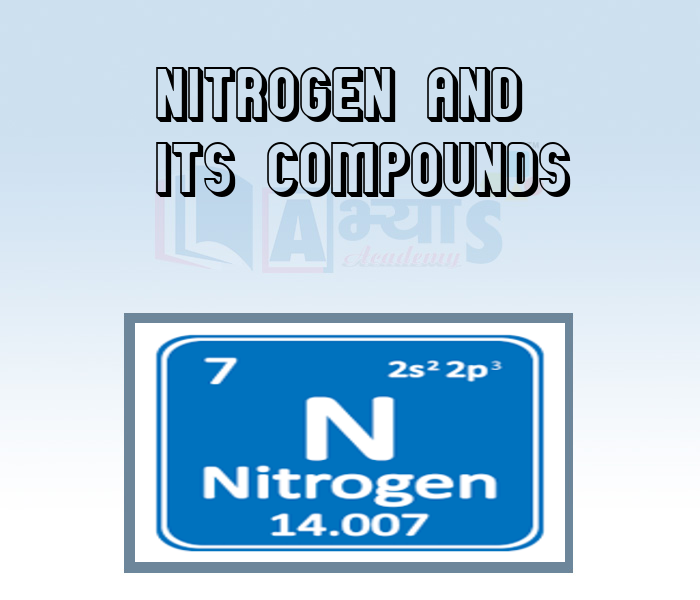Nitrogen and Its Compounds










Nitrogen and Its Compounds
Nitrogen (N) And Its Compounds: Nitrogen is a chemical element (atomic number 7; atomic weight 14.0067). The electronic configuration is (2, 5). Nitrogen is a gas under normal conditions. Its molecular formula is Na. Molecular nitrogen is the principal constituent of the atmosphere (78% by volume of dry air) in which its concentration is a result of the balance between the fixation of atmospheric nitrogen by electrical (lightning), and chemical (industrial) action, and its liberation through the decomposition of organic materials by bacteria or combustion. In the combined state, nitrogen occurs in a variety of forms. It is a constituent of all proteins (both plant and animal) as well as of many other organic materials. Itschief mineral source is sodium nitrate.
Ammonia (): It is a colourless and alkaline gas. It is soluble in water and possesses a choking smell.
Commercially ammonia is manufactured by Haber's process.
The ease of liquefaction and heat absorption make ammonia an effective refrigerant. The largest use of ammonia is as a fertiliser. The ammonia provides nitrogen for the soil in a form in which it can be used by plants. Hydrazine, which is often prepared from ammonia, is used as jet and rocket fuel.
Nitric Acid (): It is used in the manufacture of explosives such as nitro-glycerine, guncotton, trinitrotoluene (T.N.T.) and picric acid. It is also used in medicines, celluloid, photographic film, dyes and rayon and nitrogenous fertilisers.
Nitrogen cycle is the collective term for the natural biological and chemical processes through which inorganic and organic nitrogen are inter-converted. In this cycle, nitrogen compounds pass continuously from the soil to living things and back again and, to a lesser extent, from each of these to the atmosphere and back. This process is crucial to the maintenance of life on this planet.
Atmospheric nitrogen cannot be used as such by plants or animals; it is used by plants in the form of compounds such as ammonia or nitrates. Most soils contain some amounts of nitrates in the form of ammonia compounds or in the form of decaying plant and animal matter (humus). Plants use these nitrates as food and convert them into amino acids and proteins. Proteins, in plants, either return to the soil when the plant dies or pass on to animals that consume the plant. The animals return the nitrogenous compounds to the soil through wastes or by decay on death.
Nitrogen does not only constantly circulate between the soil and living things, it also passes back and forth between each of these and the atmosphere.
The conversion of nitrogen from the atmosphere into a form available to plants and, hence to animals and humans is called nitrogen fixation.
Students / Parents Reviews [20]
About Abhyas metholodology the teachers are very nice and hardworking toward students.The Centre Head Mrs Anu Sethi is also a brilliant teacher.Abhyas has taught me how to overcome problems and has always taken my doubts and suppoeted me.

Shreya Shrivastava
8thI have spent a wonderful time in Abhyas academy. It has made my reasoning more apt, English more stronger and Maths an interesting subject for me. It has given me a habbit of self studying

Yatharthi Sharma
10thWe started with lot of hope that Abhyas will help in better understnding of complex topics of highers classes. we are not disappointed with the progress our child has made after attending Abhyas. Though need to mention that we expected a lot more. On a scale of 1-10, we would give may be 7.

Manya
8thAbhyas is an institute of high repute. Yogansh has taken admission last year. It creates abilities in child to prepare for competitive exams. Students are motivated by living prizes on basis of performance in Abhyas exams. He is satisfied with institute.

Yogansh Nyasi
7thMy experience was very good with Abhyas academy. I am studying here from 6th class and I am satisfied by its results in my life. I improved a lot here ahead of school syllabus.

Ayan Ghosh
8thAbhyas institute is one of the best coaching institute in the vicinity of Ambala cantt.The institute provides good and quality education to the students.The teachers are well experienced and are very helpful in solving the problems. The major advantages of the institute is extra classes for weak...

Shreya Shrivastava
8thMy experience with Abhyas Academy has been very good. When I was not in Abhyas whenever teacher ask questions I could not speak it confidently but when I came in Abhyas, my speaking skills developed and now I am the first one to give the answer of teachers question.

Upmanyu Sharma
7thWhen I have not joined Abhyas Academy, my skills of solving maths problems were not clear. But, after joining it, my skills have been developed and my concepts of science and SST are very well. I also came to know about other subjects such as vedic maths and reasoning.

Sharandeep Singh
7thMy experience with Abhyas academy is very good. I did not think that my every subject coming here will be so strong. The main thing is that the online tests had made me learn here more things.

Hiya Gupta
8thMy experience with Abhyas academy is very nice or it can be said wonderful. I have been studying here from seven class. I have been completing my journey of three years. I am tinking that I should join Abhyas Academy in tenth class as I am seeing much improvement in Maths and English

Hridey Preet
9thMy experience with Abhyas is very good. I have learnt many things here like vedic maths and reasoning also. Teachers here first take our doubts and then there are assignments to verify our weak points.

Shivam Rana
7thAbhyas is good institution and a innovative institute also. It is a good platform of beginners.Due to Abhyas,he has got knoweledge about reasoning and confidence.My son has improved his vocabulary because of Abhyas.Teacher have very friendly atmosphere also.

Manish Kumar
10thBeing a parent, I saw my daughter improvement in her studies by seeing a good result in all day to day compititive exam TMO, NSO, IEO etc and as well as studies. I have got a fruitful result from my daughter.

Prisha Gupta
8thAbhyas academy is great place to learn. I have learnt a lot here they have finished my fear of not answering.It has created a habit of self studying in me.The teachers here are very supportive and helpful. Earlier my maths and science was good but now it has been much better than before.

Barkha Arora
10thAbhyas institute is one of the best coaching institute in the vicinity of Ambala Cantt area. The teachers of the institute are well experienced and very helpful in solving the problems of the students.The good thing of the institute is that it is providing extra classes for the students who are w...

Aman Kumar Shrivastava
10thAbhyas is a complete education Institute. Here extreme care is taken by teacher with the help of regular exam. Extra classes also conducted by the institute, if the student is weak.

Om Umang
10thThird consective year,my ward is in Abhyas with nice experience of admin and transport support.Educational standard of the institute recumbent at satisfactory level. One thing would live to bring in notice that last year study books was distributed after half of the session was over,though study ...

Ayan Ghosh
8thAbhyas Methodology is very good. It is based on according to student and each child manages accordingly to its properly. Methodology has improved the abilities of students to shine them in future.

Manish Kumar
10thIn terms of methodology I want to say that institute provides expert guidence and results oriented monitering supplements by requsite study material along with regular tests which help the students to improve their education skills.The techniques of providing education helps the students to asses...

Aman Kumar Shrivastava
10thIt was a good experience with Abhyas Academy. I even faced problems in starting but slowly and steadily overcomed. Especially reasoning classes helped me a lot.
